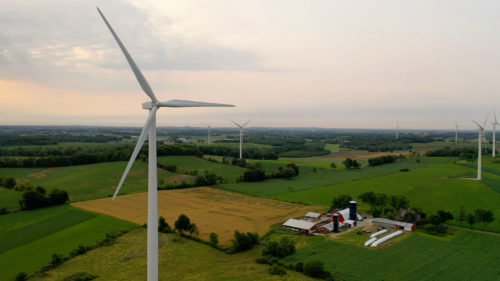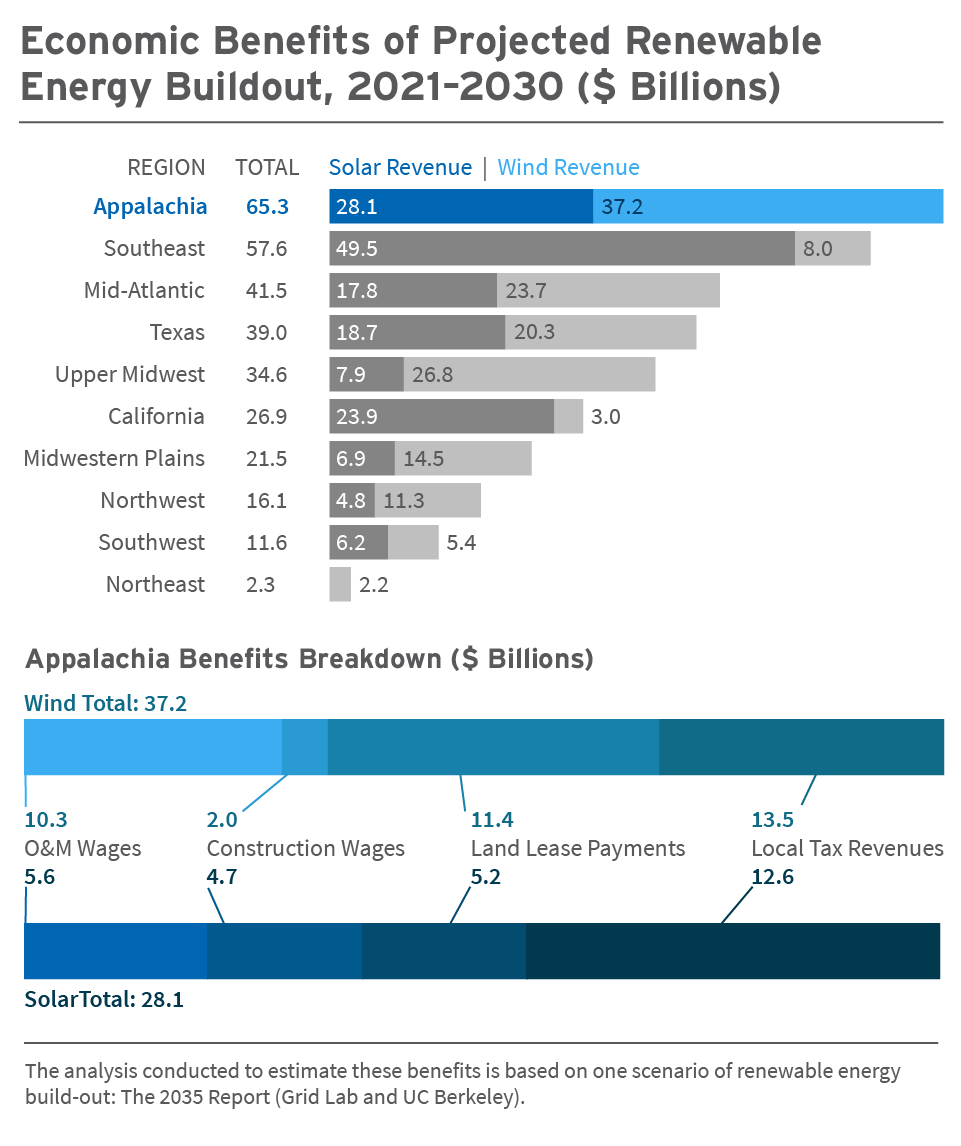Aerial view of Wind turbines, windmill, farm, agricultural fields at sunrise sunset. Rural landscape. Renewable green energy, dawn dusk sky

Reality Check: Appalachia Poised to Become Clean Energy Country
When it comes to the clean energy transition, many fear that coal-dependent regions like Appalachia will lose out or be left behind.
But a new analysis from RMI challenges that assumption, finding that Appalachia could be the region to see the biggest economic benefit from the deployment of wind and solar projects over the next decade.
For more than a century, the Appalachian Mountains stretching from Alabama to Pennsylvania have been America’s coal country. Yet global coal demand has dropped in the past decade, in part because of the fuel’s role in climate change, and coal production has fallen more than 65 percent in Appalachia, hurting the economy and creating a need for new opportunities.
Onshore wind and utility-scale solar projects can help fill that need. These projects are typically developed in rural areas with sufficient renewable resource potential and access to land—and both are plentiful in Appalachia. What’s more, ramping up renewables in the region is cost-competitive with the current trajectory of continued dependence on coal, according to a study by West Virginia University. It also offers several other notable advantages, including economic diversification and avoidance of adverse public health impacts.
That said, the transition will not be an easy one, and supporting policies that invest in worker retraining and community capacity-building are critical to ensuring that it works for everyone.
Digging into the Weeds of the Data
To understand the economic development benefits that might accrue to rural communities from renewables growth in different regions of the country, RMI analyzed the direct payments from wind and solar projects that accrue primarily to the nearby rural communities:
- Local tax revenues
- Land lease payments
- Employee wages (from construction and O&M jobs)
In this downscaling of our national Seeds of Opportunity report, we found that wind and solar-driven economic development could generate tens of billions of dollars for most regions of the country. And the benefits in Appalachia—which centers on West Virginia, Kentucky, and Ohio—are the greatest of any US region.
The analysis we conducted to estimate these benefits is based on one scenario of renewable energy build-out: the GridLab and UC-Berkeley 2035 Report. The report assumes a tripling of 2020 wind and solar capacity by 2030 and a 90 percent carbon-free grid by 2035. However, the actual economic development that communities experience will depend on the deployment that the industry achieves in this decisive decade.
If blocked or disincentivized at local, state, or federal levels of government, renewables growth could fall short. Alternatively, falling costs, rising recognition of their benefits, and policy support could result in wind and solar projects being built at larger scales and in more places than envisioned in the scenario informing this analysis. This would generate economic development levels even beyond our current estimates.
Growing Economic Development Where It’s Needed
Appalachia could see a substantial rise in economic development generated from renewables by 2030, with wind and solar contributing nearly equally across the region. Ohio and Kentucky are the states primed to see the greatest gains, adding roughly $18 billion in revenues apiece over the lifetimes of wind and solar projects built this decade, according to our analysis.
In Kentucky, those revenues are driven primarily by solar, as the state holds the potential to grow its solar capacity by an order of magnitude this decade, in the process contributing $2.6 billion in annual wages to solar industry employees. That’s comparable to those of the accommodation and food services industry in the state. A similar story holds true for West Virginia, where the solar industry could launch in a big way in the coming years, delivering over $12 million in annual tax and land lease revenues to West Virginia communities.
While Appalachia stands to reap great benefits, other regions across the country have much to gain from wind and solar deployment as well.
- As the states with the largest shares of current and planned wind and solar projects, California and Texas could see more than $65 billion in rural benefits from the renewables industry over the lifetime of solar and wind projects built between now and 2030. The potential in these states is so big, in fact, we made them their own regions.
- Wyoming, which has one of the top average wind speeds and wind power densities in the country, could realize $5 billion in rural economic benefits and over 7,000 full time jobs by 2030—more than recent annual employment in oil and gas extraction in the state.
- Montana is also poised for tremendous potential growth in the wind energy sector, increasing its installed wind capacity by 600 percent in the next nine years. Wind farms built in that period could yield over $4 billion in lifetime revenues and support roughly 6,000 full time jobs.
- South Dakota ranks close to the top for economic benefits as a share of its rural population, thanks to growing wind capacity additions and a fledgling solar industry that could grow from 1 MW today to 6,400 MW by 2030. In this scenario solar would generate $306 million in annual revenue in 2030, on par with the state’s beef and veal export industry ($339 million).
- Florida, with one of the highest solar capacity factors in the country, could add $15 billion and 55,000 full time jobs to its rural economy if the modeled 30 GW build-out of its solar sector comes to fruition.
Watering the Seeds: Recommendations for Policy Leaders
There is a strong role for state and federal leaders to play in enacting and supporting renewable energy policies that drive community and economic development in rural America, in tandem with local authorities. Legislators, regulators, and executive branch leaders can:
- Prepare new workers and transition the existing workforce. Local workers have the potential to play a bigger role in building the wind and solar projects they host, especially in states that establish and support adequate workforce development programs through community colleges, industry associations, and other educational channels. Federal funding can further spur such training and workforce development initiatives.
- Define a local policy framework for renewables. In some instances, states have established approaches to renewable energy taxation or siting that inform and streamline local treatment of projects.
- Support rural asset ownership opportunities and community wealth-building. Some communities, tribes, and rural stakeholders are interested in more opportunities to generate wealth locally by owning wind and solar projects, which state and federal policy can help support through targeted tax and incentive programs.
- Create long-term demand certainty for wind and solar development. Establishing durable energy policies that provide clear direction for the state or country’s energy future will send a strong signal to developers, businesses, and communities to invest in the needed training and infrastructure.
Wind and solar projects are becoming a new form of cash crop for rural communities around the country. With support from our elected leaders, rural areas around the United States, will see more jobs, revenue, and other economic and health benefits as they embrace renewables.

